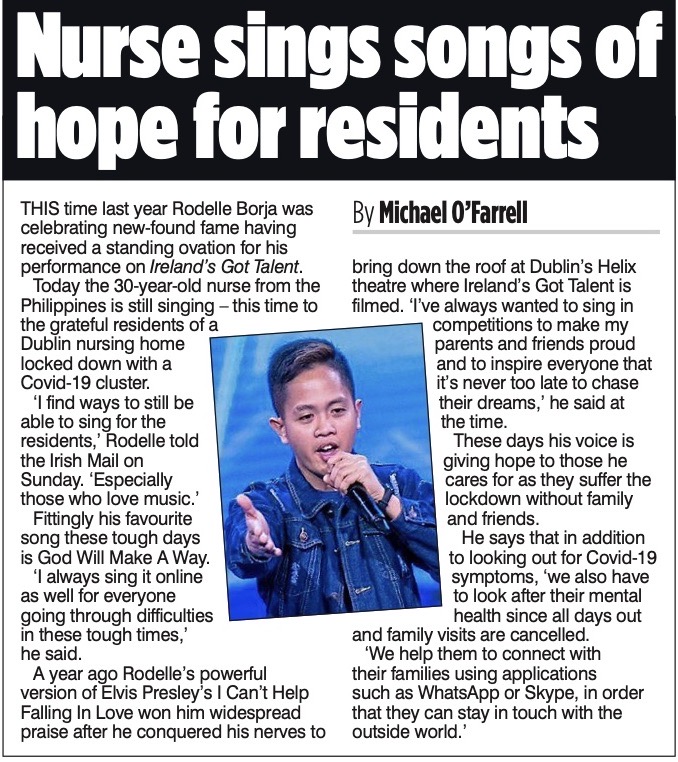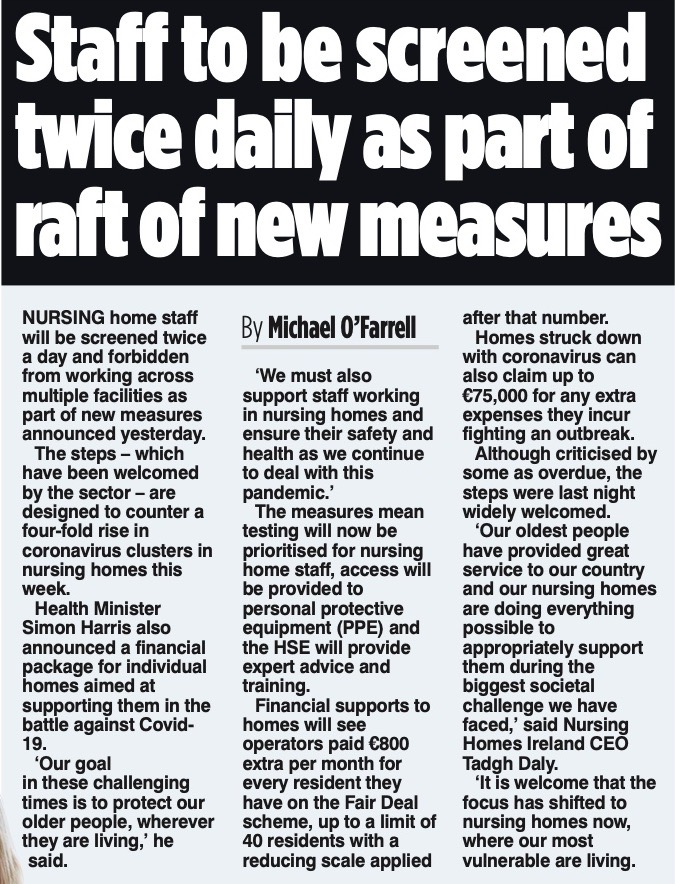By: Michael O’Farrell – Investigations Editor.
CLOSE to 10,000 vulnerable nursing home residents and their care staff have already been put at risk by the rising number of Covid-19 clusters in the sector, the latest figures indicate.
At the beginning of the coronavirus crisis, nursing homes acted faster than the Government, restricting access from March 6 – even before schools closed and societal lockdown ensued.
At the time, the Government’s Chief Medical Officer, Tony Holohan, said the move was premature. Now, at the end of a week that has seen a four-fold rise in nursing home clusters, the Government is scrambling to catch up.
Yesterday it announced a package of supports for the sector that has been widely welcomed.
But until now nursing homes – and other congregated settings of older people – have been a peculiar blind spot for the Government, which has meanwhile been channelling millions to HSE frontline services for close to a month.
The lifting of long-standing recruitment embargoes initially put even more pressure on nursing homes as vital staff departed for the HSE.
As of Wednesday there were 40 nursing home clusters – about three quarters (32) of them in the east of the country.
When you read this that number will have increased.
The cluster rate in hospitals (30 to date) is running 25% behind that of nursing homes.
Although under pressure to do so, the Government is not releasing coronavirus death rate figures for nursing home residents. The industry, fearful of panic and mindful of commercial consequences, is also reluctant to speculate about death figures.
‘This is a very high-risk population,’ Trinity College professor of ageing & community nursing Amanda Phelan told the MoS.
‘If you look at the statistics coming out about the median age of death – 82 years – it would lead you to suspect that a lot of those deaths are happenmass ing in nursing homes.’
Another source involved in Government plans for temporary morgues was even more forthright.
‘The fear is they will be obliterated,’ he said.
‘I don’t mean to be cruel but the clusters are cropping up every day.’
That fear is all the more realistic given the fact that the 30,000 living in Ireland’s 500 nursing homes are there because they already have medical issues.
Because of their ailments, their age and their communal locations these are the most vulnerable people of all – caught square in the cross hairs of the virus without any body armour.
‘This is a global emergency and a flash point is age,’ said Professor Phelan ‘A flash point is certainly nursing homes.’
Many are now asking why it took so long for the penny to drop at Government level.
Fianna Fáil’s health spokesperson Stephen Donnelly used the last available Dáil sitting on Thursday to highlight the issue.
He spoke of one Dublin home where 70 of its 200 staff had tested positive. In all, 19 of the home’s 100 residents were also positive and four had died.
‘We need to start giving the same priority to home care and nursing homes that has clearly been given to the hospital sector,’ he told the MoS last night.
‘It’s not enough to create the capacity when vulnerable people get sick..’ Professor Phelan, who is also vice president of the All Ireland Gerontological Nurses Association, knows what it’s like to fight that battle.
Last weekend, when a crisis-hit nursing home in Dublin – which has experienced Covid-19 deaths – could not find staff, she donned her PPE and stepped forward to help.
‘There is fear but people don’t particularly talk about it,’ she said of the experience.
‘They get on with it. But there is fear in staff because we know from other countries it’s not necessarily all the time the people with underlying conditions who are getting very sick and dying.’
Nursing Home Ireland CEO Tadhg Daly told the MoS that a 50-bed nursing home typically involves 70 staff. In rural areas such facilities are often the largest employer in the locality.
Any outbreak in nursing homes like these could reach far beyond the facility’s walls.
In Dublin, where many homes are bigger, a facility with 100 residents will have as many as 140 staff. That’s 240 people linked to a cluster in such a home, many of them circulating back into the community. By that measure, the 40 clusters identified to date could conservatively have endangered just under 10,000 residents and staff.
Two other core issues have likely exacerbated the problem.
Agency staff frequently work across several homes in any given week, thereby increasing the likelihood of virus spread.
And scores of care workers in homes are out of work awaiting tests before they can return, heaping pressure on homes to use transient agency staff even more.
Some of the measures announced yesterday will address these points, provided the Government is capable of ramping up testing as promised.
But in the meantime the virus has been percolating unhindered through many nursing homes.
While many were looking the other way, nursing homes may have become more potent vectors than children.
Last night sources at a Section 39 facility in Leinster, that houses many vulnerable patients, confirmed a patient had tested positive. A cluster here will be difficult to prevent and staff have taken to social media in open pleas to be provided with personal protection equipment.
HSE consultant Dr Sarah Doyle pointed out on the Late Late show on Friday that the existence of clusters in nursing homes should not have come as a surprise to anyone.
‘In some ways it’s not unexpected,’ she said.
‘We have seen it elsewhere. We do have elderly people in what we call congregate settings and we do see during flu seasons that these are places that are prone to spread of infection, so the HSE has recognised this as a risk.’
Announcing a new raft of measures aimed at protecting those in nursing homes yesterday afternoon, Health Minister Simon Harris said: ‘It is vital we leave nobody behind as we navigate our way out of this pandemic.’
For an increasing number of nursing home residents, it’s already too late.




